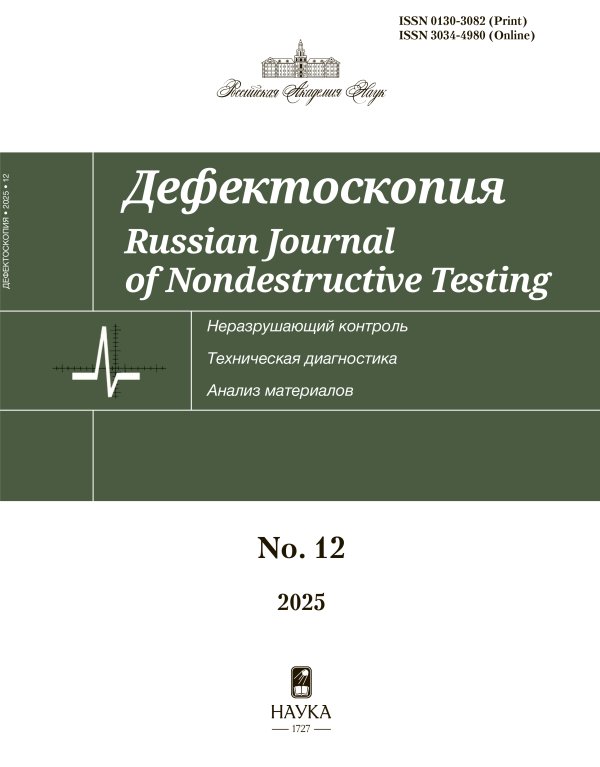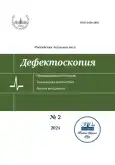№ 2 (2024)
Акустические методы
Исследование газоразрядного электроакустического преобразователя и его применение в задачах неразрушающего контроля
Аннотация
Представлены результаты исследования газоразрядного электроакустического преобразователя (ГЭАП), функционирующего на основе импульсного разряда в воздухе при атмосферном давлении. Путем измерения уровня звукового давления и регистрации амплитудно-частотного спектра колебаний мембраны получена акустическая характеристика ГЭАП в диапазоне частот от 40 Гц до 4 МГц. Изучены электротермоакустические процессы, протекающие в газоразрядной системе «открытого типа», т.е. в случае, когда объем электродной системы сообщается с внешней средой. Выявлены особенности, характерные для подобных ГЭАП, в частности возникающие при их применении в задачах неразрушающего контроля. Показано, что износ электродов и изоляции, с одной стороны, ограничивает ресурс электродной системы преобразователя, а с другой стороны, приводит к напылению микрочастиц на поверхность тестового объекта. Количественно определена скорость износа элементов электродной системы. Приведены результаты химического анализа микрочастиц, выделившихся из объекта в ходе функционирования ГЭАП. Показана возможность применения ГЭАП для бесконтактного возбуждения локальных резонансных колебаний дефектов в композиционных материалах на примере неразрушающего контроля стеклопластикового композита с применением сканирующей лазерной доплеровской виброметрии.
 3-16
3-16


Экспериментальное исследование распространения ультразвуковых волн при контроле уровня жидкости датчиком с длинным волноводом
Аннотация
Описывается ультразвуковой датчик с длинным волноводом для измерения уровня жидкости в котором используются продольная L(0,1), крутильная T(0,1) и изгибная F(1,1) волновые моды. Данные волновые моды передавались и принимались одновременно по проволоке из нержавеющей стали. Длинный волновод (>12 м) охватывает более широкую область интереса и подходит для применения в технологической промышленности в неблагоприятных условиях. В этой работе мы использовали жидкости для измерения уровня и температуры, а также такие жидкости, как дизельное топливо, вода и глицерин для измерения уровня жидкости на основе коэффициентов отражения датчика от сигналов во временной и частотной областях. Мы изучили влияние эффектов затухания волновых мод на конструкцию датчика с длинным волноводного датчика при изменении длины волновода. Первоначально мы получили коэффициенты отражения мод L(0,1) и T(0,1) от волновода длиной 12,6 м, когда один конец длинного волновода был закреплен сдвиговым преобразователем с ориентацией 45°. В дальнейшем мы хотим изучить и идентифицировать все волновые моды (особенно F-моды). Следовательно, необходимо исследовать характеристики распространения направленной волны (затухание, скорость ультразвука и частоты всех волновых мод) в длинном волноводе при систематическом разрезании с интервалом в 1 м, начиная с его первоначальной длины волновода 12,6 м, анализируя сигналы А-сканирования различных длин одного волновода. Эта простая и экономически эффективная методика позволяет контролировать большие глубины и температуру жидкости на электростанциях, в нефтяной и нефтеперерабатывающей промышленности при разработке длинного волновода датчика с соответствующими ультразвуковыми параметрами.
 17-29
17-29


Исследование шумоподавления сигналов электромагнитно-акустической эмиссии для неразрушающего контроля сплавов: метод кроссрекуррентного количественного анализа
Аннотация
Для решения проблемы, связанной с тем, что сигналы, полученные в результате локальных действий электромагнитного поля, обычно смешиваются с фоновыми шумами (особенно с белым шумом), в данной работе предложена технология разложения сигналов электромагнитной акустической эмиссии, основанная на кроссрекуррентном количественном анализе (КРКА). Для начала опытным путем или с помощью алгоритма оптимизации устанавливаются слой разложения и критерий коррекции разложения по вариационным модам (РВМ), после чего исходный сигнал подвергается разложению. Затем основные компоненты выбираются алгоритмом КРКА, и сигнал электромагнитной акустической эмиссии после разложения получается путем суперпозиционного восстановления. Результаты моделирования и экспериментов показывают, что при добавлении шума в 5 дБ метод КРКА может эффективно удалять фоновые шумы в сигналах электромагнитной акустической эмиссии по сравнению с алгоритмом коэффициента корреляции, и это может помочь в реализации высокоточного неразрушающего контроля сплавов.
 30-42
30-42


Неразрушающий контроль проникающими веществами
Контрольные образцы для капиллярной дефектоскопии
Аннотация
Разработаны образцы для капиллярной дефектоскопии, на которых возможны измерения на оптическом микроскопе как ширин раскрытия поверхностных дефектов, так и их глубин при одновременном соблюдении условий невыхождения полостей дефектов на боковые грани образцов. Приведены экспериментальные данные по зависимостям площадей следов дефектов после проявления от их раскрытий в диапазоне 0,5—8,5 мкм и глубин 40—860 мм. С использованием корреляционного анализа показана статистическая значимость вышеуказанных параметров.
 43-48
43-48


Общие вопросы дефектоскопии
Анализ результатов тестирования и качества тестов при сертификации специалистов по неразрушающему контролю
Аннотация
Анализируются результаты квалификационных экзаменов при сертификации персонала по неразрушающему контролю акустическими, магнитным и вихретоковым методами объектов железнодорожного транспорта. Проанализировано влияние уровня образования, стажа работы, возраста кандидатов на результат прохождения квалификационных экзаменов. Проведен анализ результатов общего и специального экзамена по неразрушающему контролю вихретоковым методом за 2021 и 2022 годы на выявление экстремальных вопросов теста. По методу Раша проведен анализ соответствия трудности тестовых заданий уровню подготовленности кандидатов на сертификацию. Построены характеристические кривые трудности тестовых заданий и характеристические кривые обученности тестируемых. По результатам анализа выявлены тестовые задания с завышенным и заниженным логитами трудности задания по сравнению с логитом обученности кандидатов. Оценено соответствие трудности теста уровню подготовленности персонала и равномерность распределения заданий по трудности. Рассчитан требуемый логит обученности кандидата на сертификацию для успешного прохождения тестов общего и специального экзамена.
 49-63
49-63


Современные тренды применения термоэлектрического метода в неразрушающем контроле (обзор)
Аннотация
Проведен обзор основных направлений использования термоэлектрического метода контроля в различных сферах народного хозяйства. Наиболее широко он применяется в промышленности. Имеются публикации по применению этого метода для контроля качества токарной обработки и сварки металлов методом трения с перемешиванием. Показано, что термоэлектрический метод позволяет повысить достоверность контроля и на основе данных контроля обеспечивать оптимальные режимы технологического процесса металлообработки и сварки. Ряд работ посвящен применению термоэлектрического метода для контроля пластической деформации, выявлена зависимость термоЭДС от степени пластической деформации. В последнее время появились публикации по применению термоэлектрического метода для контроля теплового сопротивления конструкции «корпус силового полупроводникового прибора—термоинтерфейс—радиатор охлаждения». Такая конструкция очень широко распространена в радиоэлектронной аппаратуре. Кроме того, имеются работы по использованию термоэлектрического метода для контроля переходного сопротивления контактов в сети электроснабжения. Показано, что с увеличением контактного сопротивления пропорционально увеличивается величина термоЭДС, что можно использовать для предотвращения аварийных ситуаций в сети электроснабжения. Термоэлектрический метод успешно применен и для диагностики степени наводораживания титана. Выявлена зависимость величины термоЭДС от степени наводораживания. Использование термоэлектрического метода не ограничивается сферой промышленного производства, он успешно применяется в медицине для безметочного обнаружения последовательностей нуклеиновых кислот, для температурной диагностики состояния зубов человека, а также для диагностики воспалительных процессов в организме человека.
 64-83
64-83












